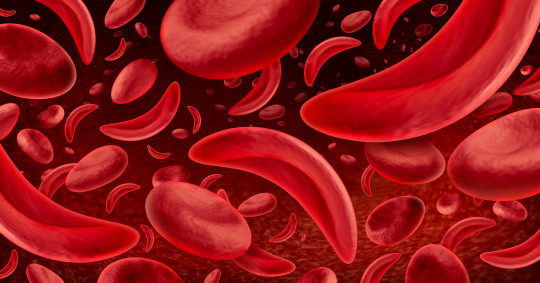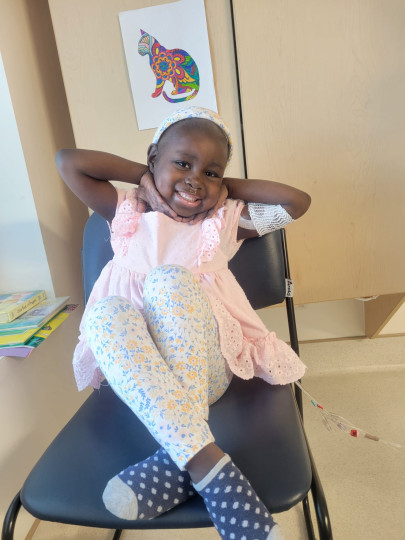World Sickle Cell Awareness Day is observed annually on June 19. The goal is to increase public knowledge and understanding of sickle cell disease (SCD), and the challenges experienced by patients and their families and caregivers—challenges seven-year-old Karahella Ady and her family know all too well.
“Karahella underwent screening just after she was born,” says her father, Frantz Ady. “We received the unfavourable results about two months later.”
SCD is a group of inherited red blood cell disorders that affect hemoglobin, the protein that carries oxygen through the body. Normally, red blood cells are disc-shaped and flexible enough to move easily through the blood vessels. In SCD, the cells become crescent—or sickle—shaped due to a genetic mutation. These cells do not bend or move easily and can block blood flow to the rest of the body.

“Signs and symptoms can vary, but the most common include anemia—which causes a patient to feel tired and weak—and jaundice, resulting in yellowing of the eyes or skin from the breakdown of red blood cells,” says Dr. Vicky Price, IWK Health pediatric hematologist-oncologist. “Episodic pain, also referred to as sickle cell crises, is a common symptom and can have sudden onset, often in the chest, arms, legs and back, caused by sickle cells blocking blood flow. The spleen, which helps fight infections, doesn’t work well and therefore people affected by SCD are more prone to infections.”
Frantz says the months following Karahella’s diagnosis were incredibly difficult. The chronic condition would continue to impact their lives in the years to come, including frequent trips from their home in New Brunswick to the IWK.
“Karahella had to learn from a very young age that she has a blood disorder and that there are certain precautions she must take. For example, she knows there are specific guidelines to follow after swimming in a pool,” Frantz recalls. “As parents, we took on jobs we didn’t particularly enjoy because they offered more flexibility, allowing us to be available if she got sick. We even changed careers to better manage our time so we could take her to her various medical appointments and follow-ups.”
“For young patients, frequent pain crises can make it hard to enjoy normal childhood activities. Hospital visits, pain episodes or feeling unwell can lead to frequent absences from school, which can affect learning and friendships. Living with a chronic illness can cause anxiety and a feeling of being different or left out,” says Price. “Parents and caregivers often live with ongoing worry watching for signs and symptoms. Seeing your child in pain and feeling helpless is stressful. Time off work and costs such as transportation to hospital appointments and medication can cause financial burden.”
While there are many challenges faced by those affected by SCD, there are treatments available to help manage symptoms, prevent complications and improve quality of life. Major breakthroughs in SCD care include, most recently, gene therapy, as well as new medications and bone marrow transplant.

“The bone marrow is like a factory inside our bones that produces blood cells. In sickle cell disease, the factory—bone marrow—makes faulty red blood cells—sickle cells,” explains Price. “A bone marrow transplant replaces the faulty factory with a new one from a healthy donor. If it works well, the new factory makes round red blood cells instead of sickle cells and that takes away the symptoms of sickle cell disease, often for good. It is not an easy process, and it is usually only done for people with severe symptoms, but it can be life-changing.”
It was, in fact, life-changing for the Ady family. In January 2024, a week before her sixth birthday, Karahella underwent a bone marrow transplant at Sainte-Justine Hospital in Montreal.
“She was admitted in early January and remained in the hospital until May. The process required an incredible amount of patience and mental resilience,” Frantz says. “There were some complications after the transplant, but the medical team managed them very well. Since she was discharged and began outpatient care, things have been going well. She is now living a healthy life, which has made a tremendous difference in our lives as parents.”
Frantz describes Karahella as a kind-hearted young girl with a vibrant and unique personality who enjoys dancing, reading and especially loves math. Her story is part of a broader shift in the landscape of SCD awareness and advocacy—one marked by growing support systems, improved treatments and empowered patient communities.
“Comprehensive sickle cell clinics, better awareness and preventative care are allowing people to live longer, healthier lives. Patient and family voices are stronger than ever, advocating for better care, school supports, mental health services and research,” Price says. “With good care, many people with sickle cell disease can lead full and meaningful lives. Hope for the future is growing stronger every year.”

